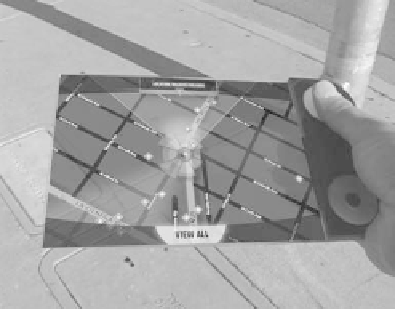Information Technology Reference
In-Depth Information
closer to the AD's eye as they approached in time. The speed with which
an item apparently approached also refl ected the priority of the item within
its color group. Such a design could be used for a lot of things besides fi lm
production, including obvious applications in medicine (e.g., surgery). The
AD could be toggled to other views: a continuity viewer, set and utilities
viewer, and a location display that mapped cast and crew. It was remark-
able. Scott could have just decided to be an oracle (obscure pun intended),
but what fun would that have been? I hope that someday he returns to and
implements an eidolon IE.
Another student whose speculative work illuminated the future of AR
was Matthew McBride (MFA class of 2005). After graduating, he worked
as Senior User Experience Designer at Schematic for four years, then be-
came User Experience Director at Possible in 2009. He described his thesis
project,
Telepath: Way-Finding in the New Urban Ecology
(2005), as seeking
to “evolve the Human Computer Interface into a Human Environmental
Interface, creating a more elegant relationship between the physical world
and the invisible ecology of digital data co-present within it.” Although
early mobile mapping software probably appeared around 2007, McBride
was thinking beyond it in 2005. His mock-up was a see-through display
with mapping capabilities, tags, and affordances for social networking as
well as way-fi nding (see Figure 6.3).
Figure 6.3.
McBride's Telepath proposed a tablet-like device that could be used for
navigation, landmark recognition, comments, and sharing, with a gestural interface.
(Photos courtesy of Matthew McBride.)



